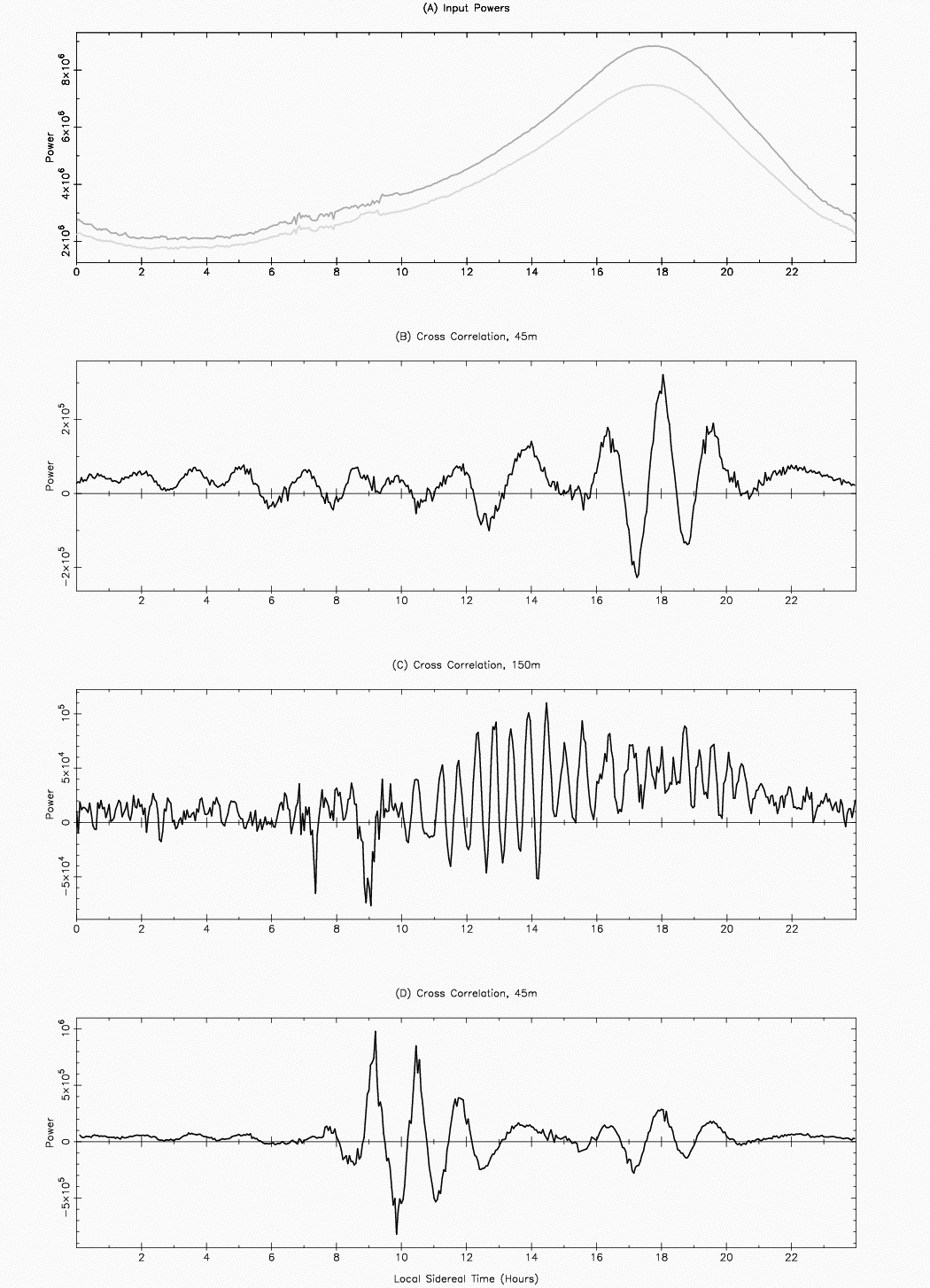Narrabri simple 20-MHz interferometer
Like most good things, it started as a lunchtime joke. Leading up to the 2001 Synthesis Imaging Workshop we were planning to introduce radio astronomy using a 20-MHz receiver, but now we had a new idea: we could build a simple two element radio interferometer. Naturally, the second receiver didn't arrive until the Friday afternoon before the Workshop and it was all something of a fizzer. Since late 2001 however, the Narrabri simple 20-MHz interferometer has been working around the clock.
The equipment behind modern scientific radio interferometers, such as the Compact Array at Narrabri, is a challenge even for experts to understand. The simple 20-MHz interferometer demonstrates many of the same scientific principles using only a few dozen electronic components and a generic PC. The system operates from the Narrabri Visitor's Centre and has proved a popular introduction to radio astronomy for several work experience students. A demonstration of the system was also warmly received at the recent "Science Education in Partnership" Fulbright Symposium.
The system uses two direct conversion receivers to bring 3 kHz of radio bandwidth down to audio frequency _ this telescope you can listen to! The kit receivers have been modified so that only a single local oscillator signal is used for the pair. All system delays are fixed with coaxial cable so the system operates as a meridian transit interferometer. The antenna for each receiver consists of two phased, North-South oriented, half wavelength dipoles separated by 7.5 m East-West. This gives each antenna a primary beam of around 60 degrees, pointing at the zenith.
A Linux PC uses a stereo sound card to sample the audio output of each receiver. Software, developed after hours by Narrabri staff, calculates the auto-correlation function for each receiver as well as the cross-correlation of the two. The results are integrated for one second then written to disk, from where a network client can request arbitrary data. The prototype client features statistical RFI identification, sidereal averaging of fringes from different days and rudimentary determination of source size/positions using an iterative model fitting algorithm.
To date, observations have been made with 150, 75, 45 and 20-m baselines. The interferometer has proved suitable for detecting a number of astronomical radio sources, including the Galactic plane, Centaurus A and the Sun.
The Galactic plane generally dominates astronomical radio emission at 20 MHz. This is evident in Figure 1A which shows 20-MHz flux against LST for the individual inputs (in arbitrary units). The maxima coincide closely with the transit of Sagittarius A, the centre of our Galaxy, at 17:45 LST. Figure 1B shows the interferometer response for a 45-m baseline, with strong fringes evident around the same time. Figure 1C shows the interferometer response with a 150-m baseline. With this baseline the Galaxy is largely resolved and the dominant fringes are now produced by the more compact, nearby radio galaxy Centaurus A, around 13:24 LST.
In addition to the non-variable sources, the Sun can become a powerful 20-MHz radio source. The quiet Sun is too weak for our interferometer to detect, however during periods of solar activity the Sun can become the brightest object in the 20-MHz sky. Figure 1D shows fringes for the 45-m baseline during a solar loud period. Contrast this with Figure 1B which shows data for the same baseline averaged over solar quiet days. In addition to direct detection of low frequency solar radio emission, our system has proved capable of indirectly detecting solar X-ray flares. These powerful events can greatly enhance solar X-ray flux, making the Earth's ionosphere more opaque. Increased ionospheric absorption leaves less cosmic signal available at our antennas so the system detects a sudden decrease in detected flux, called an ionospheric fadeout.

Figure 1: A (top) - 20-MHz flux against LST. The maxima coincide closely with thetransit of Sagittarius A, the centre of our Galaxy, at 17:45 LST. B (second from top) - The interferometer response for a 45-m baseline. The strong fringes correspond to transit of Sagittarius A. C (second from bottom) - The interferometer response for a 150-m baseline. The Galaxy is largely resolved and the dominant fringes are due to the more compact, nearby radio galaxy Centaurus A. D (bottom) - Fringes for the 45-m baseline during a solar loud period.
Construction and operation of a simple interferometer provides a rewarding and interactive format for exploring many aspects of electronics, computing and astronomy. In the longer term we plan to refine the system so that other groups and interested amateurs can consider building simple interferometer systems based on this architecture. As this is written, a self-funded simple 30-MHz interferometer is approaching first light at one author's home. This second system provides a test-bed for alternate hardware and will help to expedite software development. Stay tuned, this joke hasn't laughed its last.
David Brodrick
Tim Kennedy
Steven Tingay
and Daron Brooke
(David.Brodrick@csiro.au)
